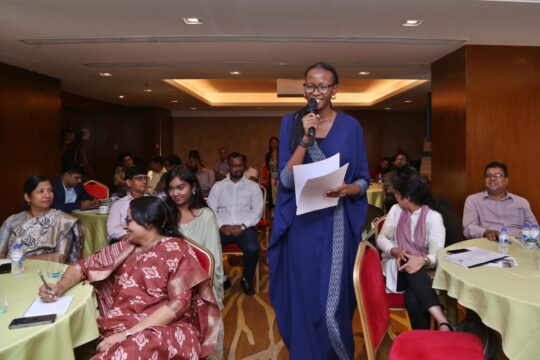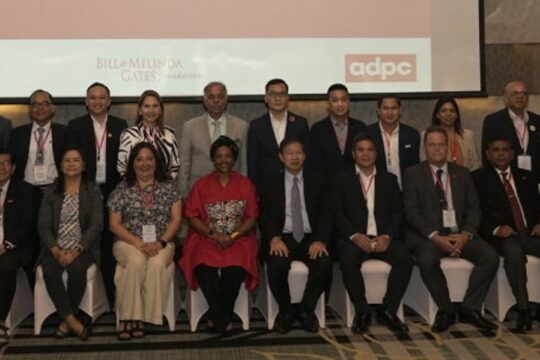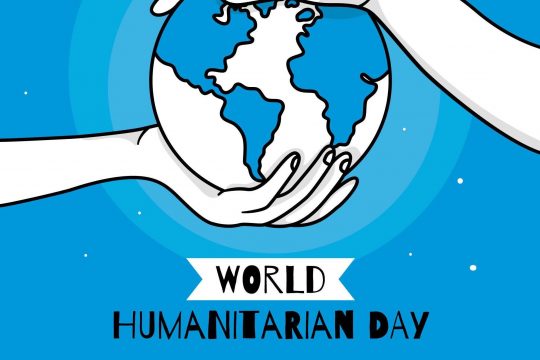Pathways to Locally Led Resilience: Unlocking Financing and Leadership for Disaster Risk Reduction and Climate Adaptation
25 July 2025 at Cinnamon Life at City of Dreams, Colombo, Sri Lanka.
The Asian Policy Dialogue on “Pathways to Locally Led Resilience: Unlocking Financing and Leadership for Disaster Risk Reduction and Climate Adaptation” was held on 25th July 2025 at the Cinnamon Life at City of Dreams, Colombo, Sri Lanka. The high-level regional peer-learning and knowledge-exchange event was jointly organised by the Asian Preparedness Partnership (APP), a flagship initiative of the Asian Disaster Preparedness Center (ADPC) and the Sri Lanka Preparedness Partnership (SLPP), co-chaired by the Disaster Management Centre (DMC), Janathakshan GTE Ltd., and the Ceylon Chamber of Commerce. The event provided a common platform to over 120 participants, including senior government officials, representatives from civil society, leaders from the private sector, development partners, and delegates from Cambodia, Lao PDR, Myanmar, Nepal, Pakistan, the Philippines, and Sri Lanka to have a dialogue on unlocking the financing and leadership for disaster Risk Reduction and Climate Adaptation.
Opening the Dialogue: Power, Partnership, and Local Leadership
In his opening address, Major General (Retd) Sampath Kotuwegoda ndc IG, Director General of the Disaster Management Centre (DMC), highlighted Sri Lanka’s commitment to a comprehensive risk management approach, highlighting the shift from reactive response models to integrated, anticipatory, and locally driven disaster governance. He stressed the importance of cross border collaboration and whole of society partnerships to meet the growing threat of multi hazard risks across the region.
Air Vice Marshal (Retd) Sampath Thuyacontha WWV, RWP and two Bars, RSP and Bar, USP, MMSc (Strat Stu- China), MSc (Def Stu) in Mgt, MSc (Def & Strat Stu), fndu (China), psc , Secretary to the Ministry of Defence, highlighted the evolving role of Sri Lanka’s Tri Forces in civil military coordination, early warning systems, and rapid response capabilities. He stated with optimism that this event is a landmark occasion to demonstrate the role of APP and underscored the need that the challenges cannot be addressed in isolation but from the shared responsibilities of different sectors. He reiterated the Ministry’s support to institutional strengthening, community capacity building, and the adoption of advanced technologies such as drones and geospatial tools in disaster operations. This was supported by stating that the goals of NDPM2023 – 2030 were now being operationalized at locations through the work supported by APP through SLPP.
Mr. Aslam Perwaiz, Executive Director of ADPC, emphasised that local leadership remains central to successful disaster risk reduction (DRR) and climate adaptation efforts. He reflected on APP’s accomplishments across seven-member countries and called for deeper investments in community led action, driven by trust, shared ownership, and long-term resilience thinking. He further emphasized that it is truly a time has come that the Asian leadership rises on demonstrating the expertise and experiences of DRM. With pride he shared the feeling of being honored to demonstrate innovative practices in 26 countries in the region. And one of the demonstrations supported by the Gates Foundation for nearly last 10 years, is the fostering and nurturing of Asian Preparedness Partnership (APP). He emphasized that a Large number of countries looking at this innovation of bringing together the three different sectors and work towards a common goal.
Dr. Valerie Bemo, Head of Emergency Response Team, Gates Foundation reflected on the journey of local leadership and resilience, emphasizing the critical need for inclusive action, equitable financing, and genuine community ownership in disaster risk reduction. She highlighted the inspiring commitment of seven countries—Lao PDR, Nepal, Myanmar, Pakistan, Philippines, Sri Lanka, and Cambodia—who have shown that transformative change is possible when local leaders, communities, private sector, and governments work together. Despite global challenges and unmet financing promises, she urged that resilience must be rooted in people, places, and partnerships. This dialogue, she noted, should be a launchpad for action—where every voice count, and communities thrive, not just survive.
Delivering the keynote address, Hon. Arun Hemachandra, Deputy Minister of Foreign Affairs and Foreign Employment, expressed strongly “When we speak of resilience, let us remember that we are not speaking only of statistics or global frameworks. We are speaking of real lives, shaped by monsoon and drafted by landslides and defined by uncertain skies. These are not hypothetical beneficiaries. These are the people whom we serve; they do not call it resilience, they call it life. “He reinforced the role of foreign affairs in facilitating regional cooperation and bi-multilateral assistance, while applauding the professionalism of Sri Lanka’s frontline responders and the longstanding partnerships with ADPC and APP. His remarks highlighted that Sri Lanka’s approach to Disaster Risk Management is evolving from isolated interventions to integrated governance, and at the heart of this shift lies the dual engine of strategic foreign engagement and grassroot coordination. Further he reassured that the Ministry of Foreign Affairs (MFA) facilitates Bi-multilateral emergency assistance in times of crisis, and coordinates with regional platforms like the Asian Preparedness Partnership (APP), BIMSTEC and SAARC.
Leaders in a frame

| Figure:1 Dignitaries at the opening of Asian Policy Dialogue 01: Hon. Arun Hemachandra, Deputy Minister of Foreign Affairs and Foreign Employment, Government of Sri Lanka 02: Air Vice Marshal Sampath Thuyacontha (Retd) WWV, RWP and two Bars, RSP and Bar, USP, MMSc (Strat Stu- China), MSc (Def Stu) in Mgt, MSc (Def & Strat Stu), fndu (China), psc 03: Major General (Retd) Sampath Kotuwegoda ndc IG, Director General, Disaster Management Centre (DMC), Sri Lanka 04: Dr. Valerie Bemo, Head of Emergency Response Team, Gates Foundation 05: Mr. Aslam Perwaiz, Executive Director, Asian Disaster Preparedness Center (ADPC) Dr. Valerie Bemo, Head of Emergency Response Team, Gates Foundation Dr. Valerie Bemo, Head of Emergency Response Team, Gates Foundation |
From the Desk of UN Secretary-General
The panel discussion opened with a video of António Guterres, UN Secretary‑General setting the tone and highlighting a new wave of energy towards repairing our relationship with the climate – focusing on people’s security, a smart economy, and advancing the SDGs.
Moderator Insights: Urgency, Unity, and Locally Led Action
The moderators brought powerful perspectives on localization:
“The world cannot wait – innovative partnerships like the Asian Preparedness Partnership show how multi-sector stakeholders can unite to empower communities.” – Ms. Pilar Pacheco — Senior Program Officer, Emergency Response, the Gates Foundation
“If we are to achieve global frameworks; local leadership, local financing, and local action are critical.” – Dr. Sisira Madurapperuma — Director, Preparedness and Climate Action, Asian Disaster Preparedness Center (ADPC)
They moderated the dialogue under the following thematic areas to get the critical insights from the leaders of localization from the APP member countries.
The panel in a frame:

Figure 2 The Panel Discussions
01: The Panel
02: Moderators: Ms. Pilar Pacheco — Senior Program Officer, Emergency Response, the Gates Foundation and Dr. Sisira Madurapperuma — Director, Preparedness and Climate Action, Asian Disaster Preparedness Center (ADPC)
03: Mr. Socheath So – Project Management Unit Manager, National Committee for Disaster Management (NCDM), Cambodia
04: Mr. Viboon Sithimolada – Executive Board Member, Lao National Chamber of Commerce & Industry (LNCCI), Lao PDR
05: Mr. Ngwe Thein – Executive Director, Capacity Building Initiative (CBI), Myanmar
06: Dr. Tokraj Pandey – Joint Secretary, Ministry of Home Affairs (Nepal)
07: Mr. Hameed Ullah Kakar – Chairperson, National Humanitarian Network (NHN)
08: Ms. Loreine B. Dela Cruz – Executive Director, Center for Disaster Preparedness Foundation, Philippines
09: Mr. Chathura Liyanaarachchige – Director – Preparedness, Disaster Management Centre, Sri Lanka
Exploring practical strategies to empower local leaders
Empowering local leadership across the region requires context-specific strategies that balance authority, accountability, and access to resources. In the Philippines, taking ownership of disaster risk reduction and climate adaptation involves a layered approach—building trust, sharing power, and nurturing a clear vision. Strengthening local governance structures and ensuring autonomy are seen as fundamental steps toward realizing that vision. Inclusion, participatory processes, and ethical storytelling are critical for validating community knowledge and transforming it into actionable resilience strategies. Access to resources is emphasized as the bridge between planning and implementation.
Lao PDR views local leadership not as an end but a means to catalyze action. This demands structured planning, clearly defined roles and responsibilities, and a strong accountability mechanism at the local level. In Myanmar, capacity building is essential to equip them with the knowledge and tools needed for effective preparedness, response, and recovery. Cambodia stresses the importance of creating enabling policy environments and legal frameworks that open strategic space for local action. By aligning available resources with community engagement, they empower people to recognize their roles and actively contribute to their households, communities, and the broader national agenda.
Ensuring inclusivity in local leadership
Nepal leverages its three-tier government system to include vulnerable groups in local leadership and policy processes. These groups actively participate in planning and implementation, with growing influence at both local and national levels.
Sri Lanka aligns its national policy with global frameworks, focusing on inclusive local DRR planning. Programs like the Climate Resilience Integrated Water Management Program use vulnerability data using natural boundaries to guide decisions which are inclusive of the marginalized communities across the natural boundaries of the river basin, though financing remains a key challenge.
Pakistan highlights the need to embed marginalized groups within governance systems. Legal provisions ensure their representation, with practical steps like post-flood housing registered under women’s names.
Cambodia prioritizes creating enabling environments for participation. Inclusion is fostered through intentional design—such as translation services—ensuring access and engagement beyond the token representation.
The key take-away to ensure inclusivity in local leadership is to have an enabling environment where people have means to reach the table of leadership. Ensuring a feedback mechanism is one of the practical ways to take the voices of the vulnerable communities into the decision making.
Advancing Effective, Transparent and Accountable Financing
Financing for locally led DRR and climate adaptation requires innovative, inclusive, and sustainable approaches across the region. In Pakistan, stakeholders emphasized the importance of local pooled funds, CSR contributions, and stronger government–CSO collaboration. They also called for the development of local insurance schemes and enabling mechanisms to channel international funds down to the local level.
The Philippines highlighted the gap between the Grand Bargain’s 25% funding commitment and the current 2% allocation to local actors. They stressed the need for simplified access to funding, capacity-building for grassroots actors, and purpose-driven financing models to support local innovation. Strategic networks and blended finance models, such as Sri Lanka’s, were cited as effective solutions.
In Myanmar, CSOs mobilized funding through local intermediary actors, ensuring nearly 100% of funds reached capable local organizations. However, limitations persist, such as funding caps and capacity gaps. The need for centralized, country-level pooled funds was emphasized.
Lao PDR focused on sustainability and private sector engagement, advocating for multi-stakeholder models and showcasing strong business cases to attract and retain investment in locally led resilience efforts.
Locally Led Action vs. Whole-of-Society: A False Dichotomy?
The idea that locally led action and a whole-of-society approach are mutually exclusive is increasingly being challenged across the region. Pakistan emphasized that “local” refers to those who experience and respond to disasters first—the communities most affected. Empowering them with the right capacities is not optional, it’s essential. The Philippines reinforced that the local exists at multiple levels—national, subnational, city, municipal, and barangay—and that every layer has a role. They argued that addressing climate and disaster risks is everyone’s business, and that locally led action naturally aligns with a whole-of-society model when all stakeholders—government, civil society, academia, private sector, and communities—act together.
Sri Lanka highlighted that the definition of “local” is context-dependent. On the global stage, a country may be considered local, while domestically, local could refer to grassroots administrative units like the Grama Niladhari (GN) level. Local CSOs, when aligned with national priorities, not only reinforce the national agenda but also create a bridge to international funding. Nepal succinctly encapsulated the approach: localization is the process of “thinking globally and acting locally”—a concept that inherently supports both local leadership and collective action.
These insights affirm that locally led action and the whole-of-society approach are not contradictory—they are two sides of the same coin. One anchors action in local realities; the other ensures it is shared, supported, and sustainable.
Power Without Tools? Addressing Gaps in Local Decision-Support Systems
While the push for localization gains momentum, many local actors still face procedural barriers that limit their ability to make timely, informed decisions. Cambodia highlighted the need to view locally led action as an investment—much like raising a child—where sustained support builds long-term capability. Despite nearly a decade of investment, locally led mechanisms are yet to be mainstreamed as tools for broader development, not just disaster risk reduction. Global and national shifts in priorities continue to create cascading constraints. To ensure sustainability, the mechanism of using the unused funding like that of CERF must be adapted to support local leadership, not just emergency response.
In Pakistan, procedural bottlenecks such as delayed NOCs restrict the ability of proven CSOs and networks to respond swiftly. Streamlining these processes and advocating for localized authority are essential steps toward meaningful decentralization.
Lao PDR emphasized that decision-making must be accompanied by clear roles, accountability, and community ownership. With over 8,000 villages—30% of which are highly vulnerable—the strategy is to localize within an agreed framework, expanding Terms of Reference and involving communities in planning. True local decision-making, they argue, must be grounded in clarity, capacity, and trust.
Together, these perspectives underscore a critical truth: granting authority without the necessary tools, resources, and enabling systems is not empowerment—it’s abdication. Bridging these gaps through this partnership is essential to making local leadership not only possible, but effective
Measuring What Matters: Assessing the Impact of Locally Led Actions
Assessing the true impact of locally led action requires a shift from traditional metrics to community-rooted evidence. Cambodia emphasized self-reliance and community participation as foundational indicators—where communities plan and implement their own resilience activities. Empowerment itself becomes the measure.
The Philippines illustrated impact through grant-making to people’s organizations, enabling them to build local assets and initiate grassroots activities. However, they also called out the prevailing donor narrative, where impact is often told through intermediary organizations rather than the communities themselves. Ethical storytelling, grounded in community voices, is seen as vital to capturing authentic evidence and shifting funding priorities.
Sri Lanka acknowledged the presence of success stories and case studies but noted the challenge in systematically measuring long-term outcomes. There is a clear need for structured monitoring systems that go beyond anecdotal evidence to track reductions in loss, improved resilience, and lasting local capacity.
These insights point to a broader challenge: if we are to truly value locally led actions, we must build inclusive, community-informed systems that measure what matters—not just what’s easy to count.
Conclusion to the Dialogue
The dialogue reaffirmed that locally led action is not only essential—it is inevitable for building resilient, inclusive, and sustainable futures. Across diverse contexts, panelists emphasized that local actors are not passive recipients but active drivers of preparedness, response, and recovery. However, for this potential to be fully realized, local leadership must be supported with the right tools, flexible financing, inclusive systems, and political will.
From navigating structural constraints to rethinking impact measurement, the discussion highlighted that locally led action and whole-of-society approaches are not at odds but are mutually reinforcing. Empowerment, trust, and investment in local capacity must go hand in hand with accountability, collaboration, and ethical storytelling.
As we move forward, the path to meaningful localization requires more than advocacy—it demands commitment to concrete actions: fostering regional collaboration, building capacity, sharing power, embracing inclusion, enhancing coordination, acting with urgency, and trusting the process.


